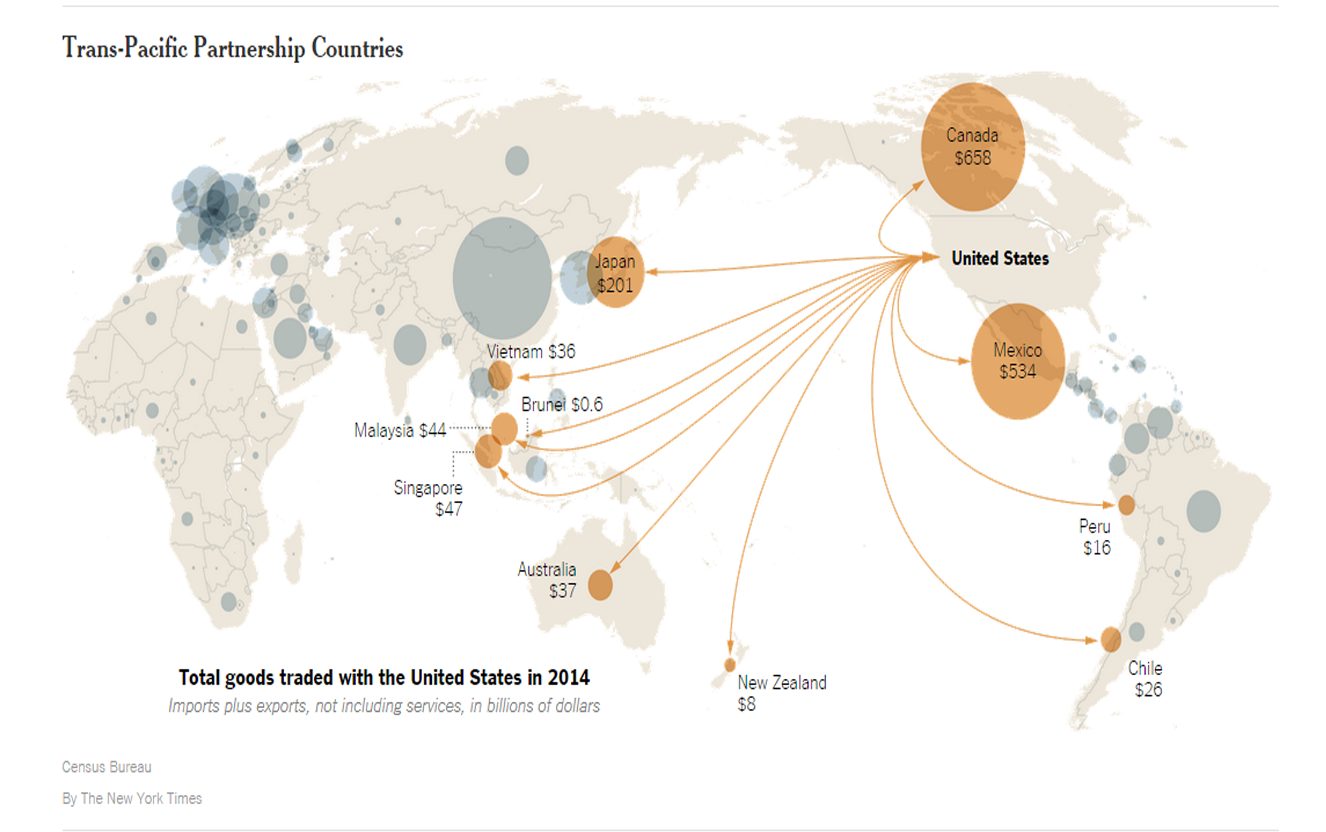Biggest Trade Deal Ever: Trans-Pacific Partnership
Biggest Trade Deal Ever: Trans-Pacific Partnership
The trade delegates involved with The Trans-Pacific Partnership agreement finally reach a deal.
The Trans-Pacific Partnership is made up of 12 countries, including The United States. This partnership makes up the largest regional trade collaboration in history, however still faces much debate after already eight years of discussion… especially in the upcoming elections.
Countries include: USA, Canada, Mexico, Peru, Chile, Japan, Vietnam, Malaysia, Singapore, Australia, Brunei, New Zealand
Photo Source & Facts from Census Bureau / NY Times:
Total goods traded with the United States in 2014 Imports plus exports, not including services, in billions of dollars
What will the partnership do?
According to Jackie Calmes with the NY Times, the partnership agreement “would phase out thousands of import tariffs as well as other barriers to international trade. It also would establish uniform rules on corporations’ intellectual property, open the Internet even in communist Vietnam and crack down on wildlife trafficking and environmental abuses.”
According to Chris Gillis with American Shipper, “some of the last minute wrangling between the countries focused on market access for dairy and certain pharmaceutical products.”
Other arguments posed by the deal:
“The Office of the United States Trade Representative said the partnership eventually would end more than 18,000 tariffs that the participating countries have placed on United States exports, including autos, machinery, information technology and consumer goods, chemicals and agricultural products ranging from avocados in California to wheat, pork and beef from the Plains states.
Japan’s other barriers, like regulations and design criteria that effectively keep out American-made cars and light trucks, would come down.
While many opponents object that the trade pact will kill jobs or send them overseas, the administration contends that the United States has more to gain from freer trade with the Pacific nations. Eighty percent of those nations’ exports to the United States are already duty-free, officials say, while American products face assorted barriers in those countries that would end.
Also, the administration contends that increased United States sales abroad would create jobs in export industries, which generally pay more than jobs in domestic-only businesses.” [NY Times]
How else does the partnership help American exports?
“According to a report released by the Office of the U.S. Trade Representative this summer, U.S.-manufactured footwear in TPP nations currently faces quotas and tariffs of more than 100 percent. The United States exported $824 million of footwear worldwide in 2014, and $370 million of that went to TPP countries. In another example, tariffs on U.S.-made building products in TPP countries are as high as 60 percent. TPP countries imported nearly $29 billion of the $46 billion in global U.S. exports of U.S. building products in 2014.
Many U.S. agricultural exports to TPP member countries face even higher tariffs. USTR noted, for example, the United States exported $6.7 billion in pork products overseas in 2014, with $4.7 billion of that imported by TPP countries.” [American Shipper]
There are some interesting comments on the NY Times – why don’t you email us your comments too ? I would be happy to publish them in the next newsletter anonymously and encourage discussion.
Send to Ktaylor@scarbrough-intl.com.

